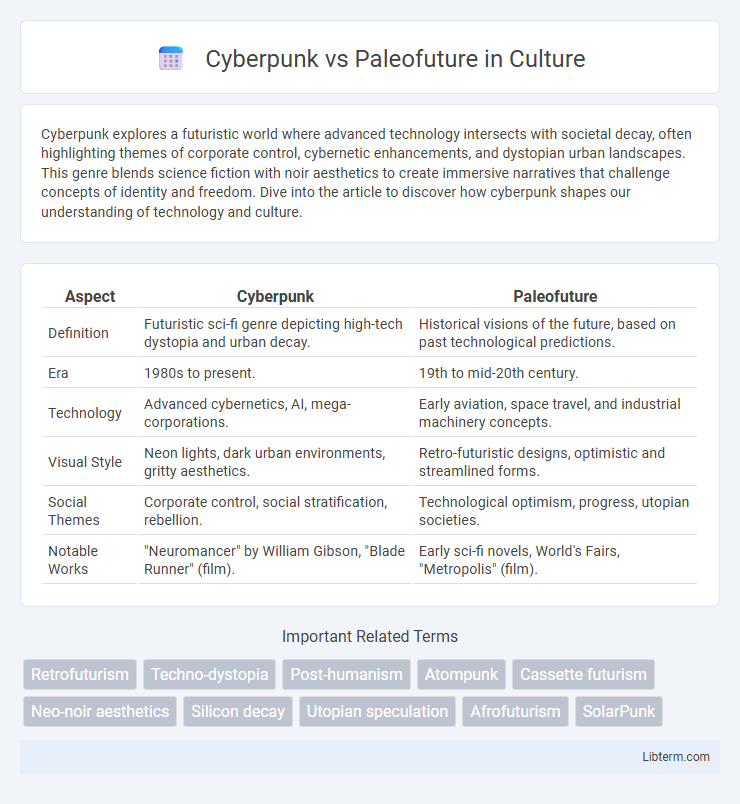Cyberpunk explores a futuristic world where advanced technology intersects with societal decay, often highlighting themes of corporate control, cybernetic enhancements, and dystopian urban landscapes. This genre blends science fiction with noir aesthetics to create immersive narratives that challenge concepts of identity and freedom. Dive into the article to discover how cyberpunk shapes our understanding of technology and culture.
Table of Comparison
| Aspect | Cyberpunk | Paleofuture |
|---|---|---|
| Definition | Futuristic sci-fi genre depicting high-tech dystopia and urban decay. | Historical visions of the future, based on past technological predictions. |
| Era | 1980s to present. | 19th to mid-20th century. |
| Technology | Advanced cybernetics, AI, mega-corporations. | Early aviation, space travel, and industrial machinery concepts. |
| Visual Style | Neon lights, dark urban environments, gritty aesthetics. | Retro-futuristic designs, optimistic and streamlined forms. |
| Social Themes | Corporate control, social stratification, rebellion. | Technological optimism, progress, utopian societies. |
| Notable Works | "Neuromancer" by William Gibson, "Blade Runner" (film). | Early sci-fi novels, World's Fairs, "Metropolis" (film). |
Defining Cyberpunk and Paleofuture
Cyberpunk is a subgenre of science fiction characterized by futuristic, dystopian settings where advanced technology coexists with societal decay and cybernetic augmentation, often exploring themes of cybernetics, artificial intelligence, and corporate control. Paleofuture refers to past visions and predictions of the future from earlier eras, reflecting historical hopes and fears about technological progress and societal change through speculative designs and narratives. Defining cyberpunk involves understanding its gritty, high-tech low-life aesthetics, while paleofuture centers on retrofuturism and historical futurism that reveal cultural attitudes toward innovation and modernity.
Origins and Historical Context
Cyberpunk emerged in the early 1980s, rooted in the socio-political anxieties of rapid technological advancement and urban decay, often inspired by authors like William Gibson and films such as "Blade Runner." Paleofuture traces its origins to early 20th-century Futurism and modernist visions, reflecting historical optimism about technology and progress through retro-futuristic art and literature. Both genres explore futuristic themes but from contrasting perspectives--Cyberpunk delves into dystopian cybernetic realities, while Paleofuture nostalgically imagines a utopian technological past.
Key Themes and Motifs
Cyberpunk explores dystopian futures dominated by advanced technology, cybernetics, and corporate control, emphasizing themes of identity, surveillance, and rebellion. Paleofuture centers on optimistic visions of the past's imagined futures, highlighting motifs of retro-futurism, utopian technology, and societal progress. Both genres contrast technological impact on humanity but differ in tone, with cyberpunk's gritty skepticism opposing paleofuture's hopeful imagination.
Aesthetic Styles and Influences
Cyberpunk aesthetic style is defined by neon-lit urban landscapes, dystopian technology, and a fusion of high-tech and low-life elements inspired by 1980s science fiction. Paleofuture, in contrast, draws on retro-futuristic visions from the early 20th century, showcasing optimistic designs like streamlined vehicles, flying cars, and Art Deco influences rooted in historical technological predictions. While cyberpunk reflects societal anxieties about corporate control and digital overload, paleofuture embodies nostalgic aspirations for a utopian technological future.
Technology: Utopian vs Dystopian Visions
Cyberpunk envisions technology as a dystopian force, highlighting rampant surveillance, corporate control, and social decay driven by advanced yet oppressive innovations. Paleofuture imagines a utopian use of technology, showcasing sleek, optimistic designs and breakthroughs that promise to elevate society through harmony and progress. These contrasting perspectives reveal deep cultural anxieties and hopes about the role of technology in shaping human destiny.
Societal Structures and Power Dynamics
Cyberpunk envisions dystopian societies dominated by powerful megacorporations and fragmented social orders where technology exacerbates inequality and surveillance fosters control. Paleofuture imagines a more optimistic societal structure rooted in technological progress driving centralized governance and collective prosperity. The power dynamics in cyberpunk highlight individual rebellion against oppressive elites, whereas paleofuture emphasizes harmony between innovation and societal advancement.
Iconic Works and Creators
Cyberpunk's iconic works include William Gibson's "Neuromancer" and Ridley Scott's film "Blade Runner," both pioneering the genre's depiction of dystopian futures dominated by high-tech and low-life themes. Paleofuture highlights speculative visions from the past, with influential creators like Hugo Gernsback and his early 20th-century magazines, which imagined advanced technologies and societal changes early in the space age era. These contrasting genres reflect distinct narrative foundations: cyberpunk's gritty, urban tech noir versus paleofuture's optimistic and sometimes naive technological forecasts.
Representation in Film, Art, and Literature
Cyberpunk and Paleofuture distinctly shape representation in film, art, and literature by emphasizing contrasting visions of technological impact. Cyberpunk, characterized by dystopian urban landscapes, advanced cybernetics, and corporate dominance, features prominently in works like Ridley Scott's "Blade Runner" and William Gibson's novel "Neuromancer," highlighting gritty realism fused with high-tech motifs. Paleofuture explores optimistic, retro-futuristic concepts rooted in early 20th-century predictions, depicted in art deco designs, vintage science fiction, and films such as "The Rocketeer," where imagination reflects technological optimism and nostalgia for a future that never arrived.
Impact on Popular Culture
Cyberpunk's gritty, neon-lit dystopias influenced popular culture by shaping futuristic aesthetics in films, video games, and fashion, emphasizing themes of high-tech and low-life. Paleofuture captivated audiences by reimagining past futuristic visions, inspiring retro-futuristic art and design that highlight nostalgia and alternate technological progress. Both genres drive cultural fascination with technology's possibilities and societal impacts, fueling innovation in storytelling and visual media.
The Future of Speculative Futurism
Speculative futurism explores contrasting visions such as Cyberpunk's dystopian, high-tech societies and Paleofuture's idealized past futures, each shaping cultural perceptions of what lies ahead. Cyberpunk emphasizes advanced technology, urban decay, and societal fragmentation, while Paleofuture reflects nostalgia for once-imagined innovations and utopias from previous eras. The future of speculative futurism integrates these perspectives, influencing how technology, society, and human potential are imagined and represented in media and academic discourse.
Cyberpunk Infographic

 libterm.com
libterm.com